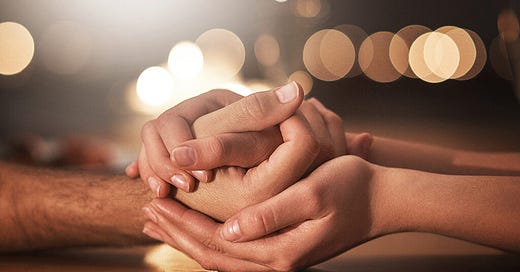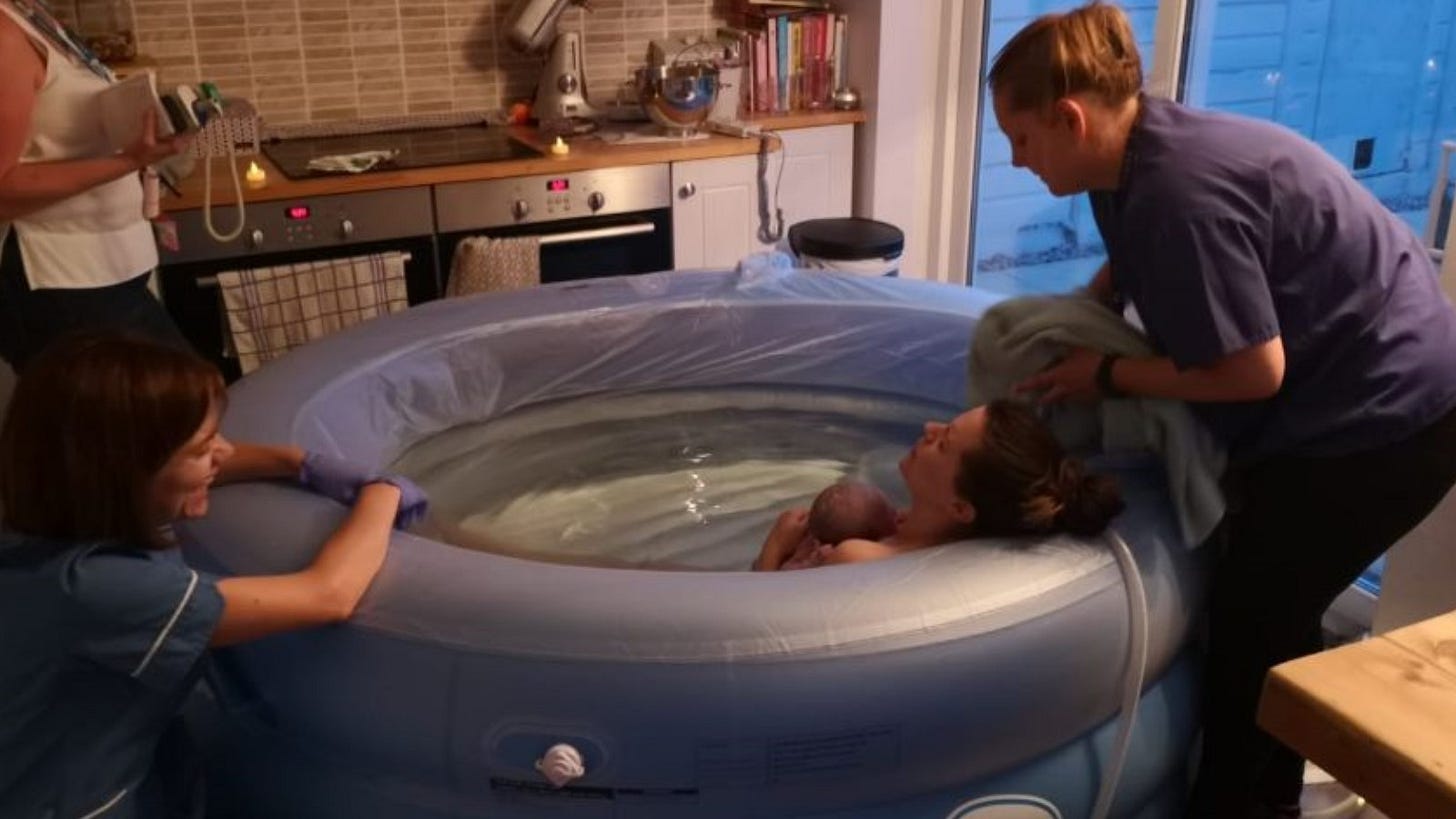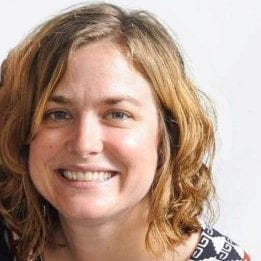Doulas for the Other End of Life's Journey
You can get a doula for the beginning of life. Why not the end of it?
My chiropractor1 and I have a weird relationship that goes beyond the professional2. We’ve become friendly and probably know too much about the other’s lives3. We’re also pretty relentless at giving each other shit about what the other person has done. For instance, she has delivered all four of her kids at-home in a kiddie pool with the aid of a doula and midwife. This is perfectly acceptable fodder for our back and forth:
I mean, why would you use a hospital for something like this where nothing ever goes wrong?
Doctors, schmoctors! I’ll trust someone who took an online course to deliver my kid.
So, did you buy the kids a new pool after the baby was born or just hose it out really good?
It’s all in fun and, honestly, I don’t care how she gave birth as long as she and the baby were healthy. Hospital, midwife, St. Olaf’s most famous OBMAG, whatever. Our relationship is built on good rapport, mutual care for one another, and my spending $70 per session so I can turn my neck without searing pain.
That style of childbirth wasn’t right for my wife and me4, but in hindsight we might have benefited from a doula when our first one came along. Those first few weeks as new parents were a challenge and the concept of someone who provides emotional support during and after the pregnancy would have been a help.
It shouldn’t come as a surprise that doulas exist for both ends of the life continuum. Just as there are birthing doulas, there are end of life doulas, which are the natural progression of the support system surrounding hospice care and palliative medicine5.
ProPublica summarizes the history of hospice care so well in a 2022 article6:
The philosophy of hospice was imported to the United States in the 1960s by Dame Cicely Saunders, an English doctor and social worker who’d grown appalled by the “wretched habits of big, busy hospitals where everyone tiptoes past the bed and the dying soon learn to pretend to be asleep.” Her counterpractice, which she refined at a Catholic clinic for the poor in East London, was to treat a dying patient’s “total pain” — his physical suffering, spiritual needs and existential disquiet. In a pilot program, Saunders prescribed terminally ill patients cocktails of morphine, cocaine and alcohol — whiskey, gin or brandy, depending on which they preferred. Early results were striking. Before-and-after photos of cancer patients showed formerly anguished figures knitting scarves and raising toasts.
Saunders’ vision went mainstream in 1969, when the Swiss-born psychiatrist Elisabeth Kübler-Ross published her groundbreaking study, “On Death and Dying.” The subjects in her account were living their final days in a Chicago hospital, and some of them described how lonely and harsh it felt to be in an intensive-care unit, separated from family. Many Americans came away from the book convinced that end-of-life care in hospitals was inhumane. Kübler-Ross and Saunders, like their contemporaries in the women’s-health and deinstitutionalization movements, pushed for greater patient autonomy — in this case, for people to have more control over how they would exit the world. The first American hospice opened in Connecticut in 1974. By 1981, hundreds more hospices had started, and, soon after, President Ronald Reagan recognized the potential federal savings — many people undergo unnecessary, expensive hospitalizations just before they die — and authorized Medicare to cover the cost.
If you’re like me and from the Central New York area, hospice isn’t just a service but a brand; Hospice of CNY provides the bulk of home-based hospice care locally. I’m a quarter-century removed from my own experience with them, but my mother was assigned a nurse and home health aide. The nurse made multiple visits per week and tended to medical needs, while the home health aide was with my mother five days a week while my father was at work. I wasn’t there during the last month of her life, but I’m told that the nurse became a more frequent presence in the house. I can’t tell you whether she provided anything doula-like.
End-of-life doulas are a relatively new concept, coming to be in the late 1990s out of hospice care. Once hospice became a regular component of medical care at the end-of-life, those staff members found themselves filling a hole for individuals and families during the most critical times in this journey. Hospice nurses, who were providing medical care were also informally counseling the person dying and their families. As Barbara Karnes, a pioneer in the field, wrote:
My care was to support, guide, nurture and be a presence during the months, days, and hours before death. I didn't come with a lot of medical services (pain management when appropriate and basic physical comfort care was what was provided). I came with time and touch, that was my presence. I came with “you will not be alone during this journey” and “I can't make this life experience go away but I can walk with you through it.”
Dirt Nap Q&A: Jaime Hazard
Jaime Hazard is an end-of-life doula and wellness coach based in Ithaca, N.Y. who serves clients nationwide through her company Wind & Wing. She provides doula services for dying people and pets, and is a home funeral consultant. She graciously offered her time to discuss her work.
Generally doulas are associated with birth. Can you explain what an end-of-life doula does?
An end-of-life doula (or death doula or death midwife...so many names all for basically the same thing) is a companion to someone who is dying and to their loved ones. They serve a non-medical role and provide physical, emotional and spiritual support and resources.
How many people/families have you worked with? Do you have more than one client at a time?
I would most definitely consider myself fairly new at all of this because Covid kind of held me back. I was the full-time caregiver to four people with late-stage dementia in a private home and, also at the same time, an 85-year old woman with cancer. I did that for over two years and loved it. That's what kind of got the ball rolling for me, so to speak.
I began volunteering at my local hospice as a companion and reiki practitioner in 2018. With hospice, I've companioned about ten people until their passing. In 2021, I enrolled in the University of Vermont's End-of-Life Doula Professional Certification. After that, we were still in the midst of Covid and most places were pretty much off limits to me, so I haven't worked with anyone as a private, hands-on (non-hospice-related) doula yet. However, there's a caveat to that. I have been working as a virtual doula. I know that sounds weird, but about ten people have contacted me through my website and I've either assisted them via phone call, Zoom or directed them to the resources they needed in their area. I also have a few virtual end-of-life planning clients who I work with on a regular basis to help get their affairs in order.
Do you find that you spend more time working with the dying person or their family?
In the past, I've almost always worked with the dying person, but family members have often been present when I'm around. I can honestly say that I've truly enjoyed my interactions with each and every family member that I've met. However, my client is the dying person so I focus on them and what their needs are.
How do you find work in this space? I know birth doulas that market themselves, and others that are tied in with midwives and local/regional natural childbirthing groups. Are you referred out by funeral homes and oncologists or is this a situation where people find you?
Marketing has been extremely difficult because no one knows that an end-of-life doula even exists. And how can you look for something if you don't even know it's an actual thing? So education is my top priority at this point. I've done public presentations at my local office of the aging and have placed informational materials in their hands to give out to their clients. Also, I have another business where I make handmade crafts and sell them at local shops and events. I decided to create my own end-of-life planner that I sell alongside the rest of my crafty offerings both in stores and at events. The planner has a handmade fabric cover and inside is pretty much everything that you need to get started on making a very thoughtful and thorough end-of-life workbook/keepsake that can be handed over to your health care proxy when the time comes. Having the planner on the shelves alongside my handmade products has certainly opened up the door to conversation and education.
In the next few months, I will actually be opening my own store and event space which will feature the planners, home funeral kits, urns and shrouds. These will be on the shelves alongside local handmade crafts as a way to normalize death and bring it into an everyday space.
I will also be teaming up with a funeral director, grief counselor, shaman and estate attorney to offer monthly workshops on the topic of death and dying at the shop. For me, it's all about finding ways to meet people where they're at without being a Debbie Downer. No one really wants to think about death, so it's just about subtly letting them know that I exist and when they're ready, they know where they can go for help.
Would you say that more of your clients are alone in their journey or are you hired to support an entire family?
So far, I've found that the people who I've met usually have at least one other person in their lives: spouse, child, etc., but the caregiving has usually become too much to handle on their own (understandably) so they need help.
Marketing has been extremely difficult because no one knows that an end-of-life doula even exists. And how can you look for something if you don't even know it's an actual thing?
Without divulging too much about your clients, can we talk about what happens at the end? What is your role in those final hours? (When my mother died, we had hospice care in home. The nurse and her home health aide spent the final day at the house, but both left when family started arriving with the knowledge that we were fast approaching the end.)
For expected deaths, there are certainly commonalities during the active dying process. The body is basically starting its pre-programmed decommissioning process, so to speak. Usually the dying are very rarely awake. Their breathing becomes infrequent. There are what we call terminal secretions or what some people call the “death rattle,” which is very common. It's just a little bit of phlegm rattling around at the back of the throat making noise; it doesn't bother the dying person. Their mouth tends to hang open so I always bring little oral sponges to keep the mouth moist. Organs are shutting down so they are not going to be eating or drinking, very little urine will be produced, the skin becomes mottled, etc. So all of that looks very similar across the board. What is different is who is present, any music playing in the background, any special words spoken, and any scents in the room. Are pets around? Are kids around? All of this is the unique part about dying.
Do you feel something spiritual or extrasensory in the moment they pass? Do you feel them depart the room as a living being?
This is one of the big reasons why I wanted to get into this work is to explore this phenomenon. I have not had any definitive supernatural experiences when people were actively dying, but working with people with dementia, they were frequently seeing people in the rooms with them. I had one lady tell me all about this guy named Bob who comes to talk to her all the time and she pointed over at the wall and told me that he was standing right there. She also told me that Bob was an artist who used to live in the house. And she was correct, there was a very talented artist named Bob who did indeed live in the house but at different time periods. They had never met in life.
Caring for people with dementia, it honestly felt like they always were straddling an invisible line between this plane and another plane of existence. Like they could see things that we couldn't. I will also say that the hospice that I volunteer in always has a very special feeling. It feels like it's energetically charged. You can almost feel the coming and going of deceased loved ones visiting the patients there.
What brought you to end-of-life doula work? How did your journey lead you to this work?
When I was about 13 years old, my sister passed away from cancer. Hospice played an important part in keeping her as comfortable and pain-free as possible until she passed. I've remained forever grateful to them. Since then, I've unfortunately lost many people and beloved pets, so death has not been a stranger. I think that a perfect storm of factors lead me to becoming a doula though. Working as a caregiver to those with dementia was probably the biggest catalyst.
I imagine you find yourself becoming close to your clients and feel a sense of loss when they die. How do you process that grief in such a repetitive pattern? Have you ever just felt like you’ve had enough?
To me, I know why I'm there. I know that they are going to pass away, so I'm not going in with any false assumptions that a miracle is going to occur. It is tough. I especially have a hard time when people cry. I always cry when people cry. Some doulas say that it's not professional to cry and get emotional, but I can't help myself. I'm strong and will lead the way but I will do it with tears in my eyes. I think what has been helpful to me thus far is to have other things going on in my life — I actually work full-time in an animal diagnostic lab at Cornell University — and to space out my doula responsibilities. For example, sometimes hospice will get a hold of me and want me to immediately start with a new client after losing one and I will decline. I need some time between clients so I don't get emotionally burnt out.
Visit Wind & Wing’s website and follow them on Facebook, Instagram and YouTube.
Sharing is caring…
At least that’s what I’m supposed to tell my six-year-old, who never wants to share with anyone.
Last week was the first Griever’s Digest. The number of readers tells me that this is something you want more of, dear reader.
Sharing is good because it helps others understand that they are not alone. That’s the point of community and what we’re trying to do here at Dirt Nap. So, if you’re interested in sharing, send me an email at jaredpaventi at gmail dot com.
Final thoughts on finality…
“I thought I was gonna die. I swear I have never felt such agony. I saw my entire life flash before my eyes and I thought, 'What a shame if I die now, I'm too young…and I'm wearing the wrong underwear.'” — Rue McClanahan as Blanche Devereux on The Golden Girls.
Dirt Nap is the Substack newsletter about death, grief and dying that is written and edited by Jared Paventi. It’s published every Friday morning.
We are always looking for contributors and story ideas. Drop us a line if you have interested in either space at jaredpaventi at gmail dot com.
I’m all over social media if you want to chat. Find me on Facebook, Twitter/X and Bluesky. I’m on Threads and Mastadon at @jaredpaventi, but I don’t check either regularly. You could message me on Instagram or LinkedIn, but I’m highly unlikely to respond.
Dirt Nap is free and we simply ask that you subscribe and/or share with others. The ego boost of inflated readership stats is all we need to get by.
Keep your witch doctor opinions to yourself. I screwed up my back in high school and this is the only thing that has helped me keep my neck and back moving over the years.
Not like that, you pervert.
Plus, she’s Canadian.
My first was delivered by emergency C-section because she kept sitting on her umbilical cord and setting off the fetal heart monitor. Thirteen years later, she’s still difficult.
Hospice and palliative care are generally lumped together as end-of-life concepts, but they are different. The easy way to remember this is that palliative care is medical and hospice isn’t. More on the topic here.
The article is actually about widespread fraud in the for-profit hospice industry. It’s a scary piece and one of those times that I’m glad New York regulates the living hell out of everything.








